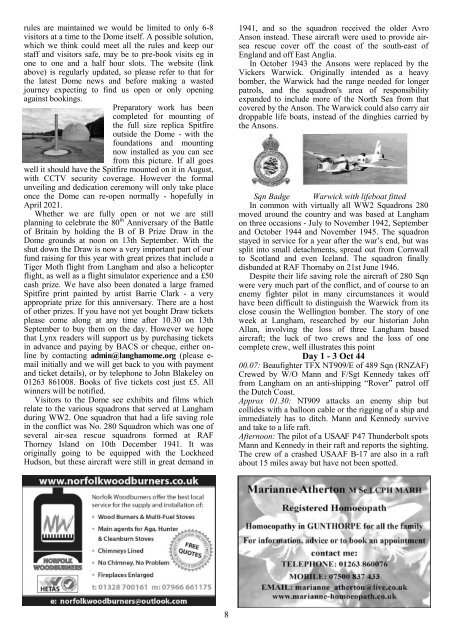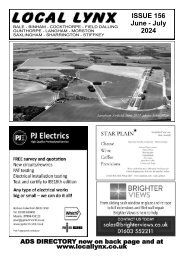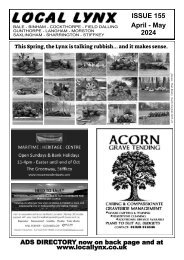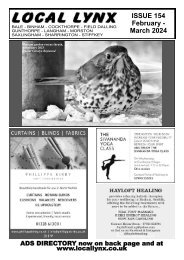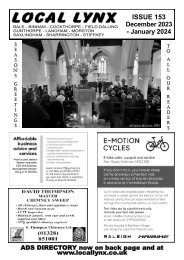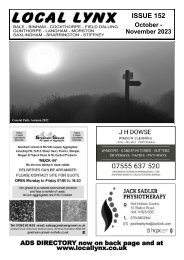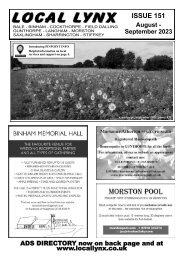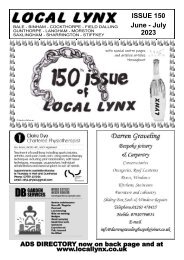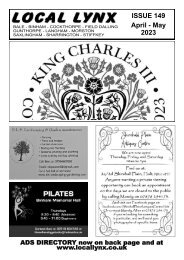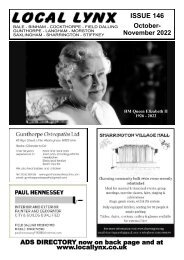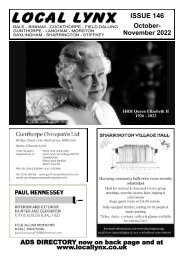Local Lynx No.133 - August/September 2020
The community newspaper for 10 North Norfolk villages
The community newspaper for 10 North Norfolk villages
Create successful ePaper yourself
Turn your PDF publications into a flip-book with our unique Google optimized e-Paper software.
ules are maintained we would be limited to only 6-8<br />
visitors at a time to the Dome itself. A possible solution,<br />
which we think could meet all the rules and keep our<br />
staff and visitors safe, may be to pre-book visits eg in<br />
one to one and a half hour slots. The website (link<br />
above) is regularly updated, so please refer to that for<br />
the latest Dome news and before making a wasted<br />
journey expecting to find us open or only opening<br />
against bookings.<br />
Preparatory work has been<br />
completed for mounting of<br />
the full size replica Spitfire<br />
outside the Dome - with the<br />
foundations and mounting<br />
now installed as you can see<br />
from this picture. If all goes<br />
well it should have the Spitfire mounted on it in <strong>August</strong>,<br />
with CCTV security coverage. However the formal<br />
unveiling and dedication ceremony will only take place<br />
once the Dome can re-open normally - hopefully in<br />
April 2021.<br />
Whether we are fully open or not we are still<br />
planning to celebrate the 80 th Anniversary of the Battle<br />
of Britain by holding the B of B Prize Draw in the<br />
Dome grounds at noon on 13th <strong>September</strong>. With the<br />
shut down the Draw is now a very important part of our<br />
fund raising for this year with great prizes that include a<br />
Tiger Moth flight from Langham and also a helicopter<br />
flight, as well as a flight simulator experience and a £50<br />
cash prize. We have also been donated a large framed<br />
Spitfire print painted by artist Barrie Clark - a very<br />
appropriate prize for this anniversary. There are a host<br />
of other prizes. If you have not yet bought Draw tickets<br />
please come along at any time after 10.30 on 13th<br />
<strong>September</strong> to buy them on the day. However we hope<br />
that <strong>Lynx</strong> readers will support us by purchasing tickets<br />
in advance and paying by BACS or cheque, either online<br />
by contacting admin@langhamome.org (please e-<br />
mail initially and we will get back to you with payment<br />
and ticket details), or by telephone to John Blakeley on<br />
01263 861008. Books of five tickets cost just £5. All<br />
winners will be notified.<br />
Visitors to the Dome see exhibits and films which<br />
relate to the various squadrons that served at Langham<br />
during WW2. One squadron that had a life saving role<br />
in the conflict was No. 280 Squadron which was one of<br />
several air-sea rescue squadrons formed at RAF<br />
Thorney Island on 10th December 1941. It was<br />
originally going to be equipped with the Lockheed<br />
Hudson, but these aircraft were still in great demand in<br />
1941, and so the squadron received the older Avro<br />
Anson instead. These aircraft were used to provide airsea<br />
rescue cover off the coast of the south-east of<br />
England and off East Anglia.<br />
In October 1943 the Ansons were replaced by the<br />
Vickers Warwick. Originally intended as a heavy<br />
bomber, the Warwick had the range needed for longer<br />
patrols, and the squadron's area of responsibility<br />
expanded to include more of the North Sea from that<br />
covered by the Anson. The Warwick could also carry air<br />
droppable life boats, instead of the dinghies carried by<br />
the Ansons.<br />
Sqn Badge Warwick with lifeboat fitted<br />
In common with virtually all WW2 Squadrons 280<br />
moved around the country and was based at Langham<br />
on three occasions - July to November 1942, <strong>September</strong><br />
and October 1944 and November 1945. The squadron<br />
stayed in service for a year after the war’s end, but was<br />
split into small detachments, spread out from Cornwall<br />
to Scotland and even Iceland. The squadron finally<br />
disbanded at RAF Thornaby on 21st June 1946.<br />
Despite their life saving role the aircraft of 280 Sqn<br />
were very much part of the conflict, and of course to an<br />
enemy fighter pilot in many circumstances it would<br />
have been difficult to distinguish the Warwick from its<br />
close cousin the Wellington bomber. The story of one<br />
week at Langham, researched by our historian John<br />
Allan, involving the loss of three Langham based<br />
aircraft; the luck of two crews and the loss of one<br />
complete crew, well illustrates this point<br />
Day 1 - 3 Oct 44<br />
00.07: Beaufighter TFX NT909/E of 489 Sqn (RNZAF)<br />
Crewed by W/O Mann and F/Sgt Kennedy takes off<br />
from Langham on an anti-shipping “Rover” patrol off<br />
the Dutch Coast.<br />
Approx 01.30: NT909 attacks an enemy ship but<br />
collides with a balloon cable or the rigging of a ship and<br />
immediately has to ditch. Mann and Kennedy survive<br />
and take to a life raft.<br />
Afternoon: The pilot of a USAAF P47 Thunderbolt spots<br />
Mann and Kennedy in their raft and reports the sighting.<br />
The crew of a crashed USAAF B-17 are also in a raft<br />
about 15 miles away but have not been spotted.<br />
8


